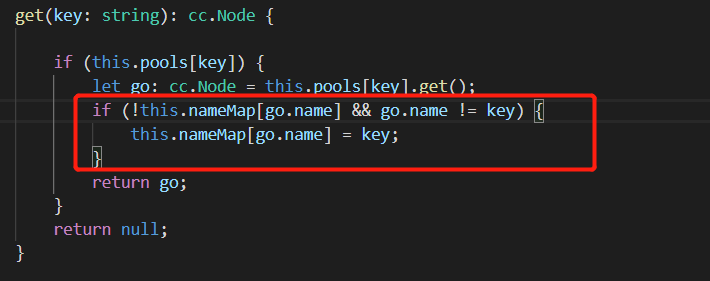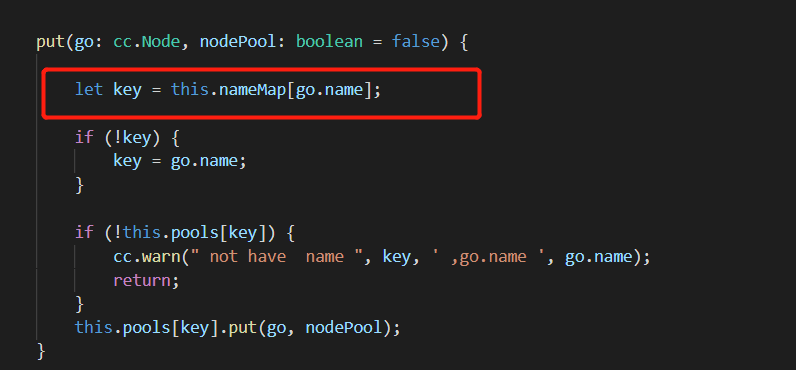为什么要使用对象池
对象池优化是游戏开发中非常重要的优化方式,也是影响游戏性能的重要因素之一。
在游戏中有许多对象在不停的创建与移除,比如角色攻击子弹、特效的创建与移除,NPC的被消灭与刷新等,在创建过程中非常消耗性能,特别是数量多的情况下。
对象池技术能很好解决以上问题,在对象移除消失的时候回收到对象池,需要新对象的时候直接从对象池中取出使用。
优点是减少了实例化对象时的开销,且能让对象反复使用,减少了新内存分配与垃圾回收器运行的机会。
Cocos官方文档说明的使用方式
https://docs.cocos.com/creator/manual/zh/scripting/pooling.html

- 这样的一个对象池,其实严格意义上来说更像是节点池,因为它已经处理了节点移除等操作。
- 无法将普通的TS对象放入cc.NodePool 进行管理。那么当我们需要对普通的TS对象进行管理的时候还是需要自己再写一个对象池。
- 好处就是回收节点的时候不需要对节点做任何操作。
- 将节点添加到场景中时不需要考虑是否存在的问题,直接addChild就可以了,因为存在于对象池中的节点必定是从场景中移除的节点。
- 在使用的过程中频繁移除和添加有性能问题。
针对以上问题,我分享一下自己使用对象池的经验。
对象池的封装
- 节点对象池
import { IPool } from "./IPool";
export default class CCNodePool implements IPool{
private pool: cc.NodePool;
private resItem: cc.Prefab;
private name: string = ''
/**
*
* @param prefab 预制体
* @param conut 初始化个数
*/
constructor(name: string, resItem: cc.Prefab, conut: number) {
this.name = name
this.pool = new cc.NodePool();
this.resItem = resItem;
for (let i = 0; i < conut; i++) {
let obj: cc.Node = this.getNode(); // 创建节点
this.pool.put(obj); // 通过 putInPool 接口放入对象池
}
}
getName() {
return this.name
}
get() {
let go: cc.Node = this.pool.size() > 0 ? this.pool.get() : this.getNode();
return go;
}
getNode() {
if(this.resItem){
return cc.instantiate(this.resItem);
}else{
console.error(' 预制体没有赋值 ')
return null;
}
}
size() {
return this.pool.size();
}
put(go: cc.Node) {
this.pool.put(go);
}
clear() {
this.pool.clear();
}
}
- 非节点对象池
export default class TSObjectPool<T> {
private pool:any [] = []
private className:string;
constructor(className:string,type: { new(): T ;},count:number = 0){
this.className = className;
for (let index = 0; index < count; index++) {
this.pool.push(new type());
}
}
getClassName(){
return this.className;
}
get<T>(type: { new(): T ;} ): T {
let go = this.pool.length > 0 ? this.pool.shift() : null;
if(!go){
go = new type();
}
return go;
}
put(instance:T){
this.pool.push(instance);
}
clear(){
this.pool = [];
}
}
对象池管理器
不论是节点对象池还是非节点对象池。我都习惯通过一个管理器封装起来使用。
这样的好处就是集中管理,修改时也非常方便。
- 节点对象池管理器
import CCNodePool from "./CCNodePool";
import SelfPool from "./SelfPool";
export default class CCPoolManager {
private static ins: CCPoolManager;
static instance(): CCPoolManager {
if (!this.ins) {
this.ins = new CCPoolManager();
}
return this.ins;
}
//对象池表
private pools = {};
// 对象名称 和给定 key的 映射表 这样在回收对象的时候就不需要传入key了。通过节点的name就可以找到key。
private nameMap = {};
init(key: string, resItem: cc.Prefab, count: number) {
if (!this.pools[key]) {
this.pools[key] = new SelfPool(new CCNodePool(key, resItem, count))
}
}
getPool(key: string) {
return this.pools[key].getPool();
}
get(key: string): cc.Node {
if (this.pools[key]) {
let go: cc.Node = this.pools[key].get();
if (!this.nameMap[go.name] && go.name != key) {
this.nameMap[go.name] = key;
}
return go;
}
return null;
}
put(go: cc.Node, nodePool: boolean = false) {
let key = this.nameMap[go.name];
if (!key) {
key = go.name;
}
if (!this.pools[key]) {
cc.warn(" not have name ", key, ' ,go.name ', go.name);
return;
}
this.pools[key].put(go, nodePool);
}
clear(name: string) {
if (this.pools[name]) {
this.pools[name].clear();
this.pools[name] = null;
}
}
clealAll() {
for (const key in this.pools) {
this.clear(key);
}
this.pools = {};
}
}
- 非节点对象池管理器
import TSObjectPool from "./TSObjectPool";
export default class TSPoolManager {
//对象池表
private pools = {}
private static ins: TSPoolManager;
static instance(): TSPoolManager {
if (!this.ins) {
this.ins = new TSPoolManager();
}
return this.ins;
}
init<T>(key: string, type: { new(): T; }, count: number = 1): void {
if (!this.pools[key]) {
this.pools[key] = new TSObjectPool(key, type, count);
}
}
/**
* 获得被销毁的对象
* @param key
*/
get<T>(key: string, type: { new(): T; }, count: number = 1): T {
if (!this.pools[key]) {
this.pools[key] = new TSObjectPool(key, type, count);
}
return this.pools[key].get(type);
}
put(key: string, obj) {
let pool = this.pools[key]
if (pool) {
pool.put(obj);
}
}
}
通用对象池
对象由外部创建。不用考虑是否为预制体创建的节点对象。
- 对象池
export default class ObjectPool<T>{
private buffList: T[] = []
private key: string;
constructor(key: string) {
this.key = key;
}
get(func: () => T) {
let item = this.buffList.length > 0 ? this.buffList.shift() : func();
return item;
}
put(obj: T) {
this.buffList.push(obj)
}
size() {
return this.buffList.length
}
destroy() {
this.buffList.length = 0;
}
}
- 对象池管理器
import ObjectPool from "./ObjectPool";
import TSMap from "../struct/TSMap";
export default class PoolManager {
private static ins: PoolManager
static instance() {
if (!this.ins) {
this.ins = new PoolManager();
}
return this.ins;
}
private map: TSMap<string, ObjectPool<any>> = new TSMap();
get(key: any, func: () => any) {
if (!this.map.has(key)) {
this.map.set(key, new ObjectPool(key))
}
return this.map.get(key).get(func)
}
put(key: any, obj: any) {
if (this.map.has(key)) {
this.map.get(key).put(obj)
} else {
}
}
size(key: string) {
if (this.map.has(key)) {
return this.map.get(key).size()
}
return 0;
}
destroy() {
this.map.clear();
}
}
针对Cocos对象池的优化

针对Cocos的这一性能问题,我利用装饰模式,自定义了SelfPool类改变了获取和回收时的操作。
import CCNodePool from "./CCNodePool";
import { IPool } from "./IPool";
/**
* 使用opacity方式隐藏对象
*/
export default class SelfPool implements IPool{
private list:cc.Node[] = []
private pool:CCNodePool;
constructor(pool:CCNodePool){
this.pool = pool;
}
get(){
let go:cc.Node = this.list.length > 0 ? this.list.shift() : this.pool.get();
go.opacity = 255;
return go;
}
getPool(){
return this.pool
}
size(){
return this.pool.size() + this.list.length;
}
/**
*
* @param go
* @param nodePool 是否放入NodePool中
*/
put(go:cc.Node,nodePool:boolean = false){
if(nodePool){
this.pool.put(go)
}else{
this.list.push(go);
go.stopAllActions();
go.opacity = 0;
}
}
clear(){
this.pool.clear();
this.list.length = 0;
}
}
在对象池初始化的时候做了这样的处理

如果不想使用隐藏方式,可以去掉这一层封装,接口都是一样的。
对象池回收的偷懒方式
在回收对象时的一贯操作是put(key,obj)
如果obj肯定拥有name或者其他某个可以标识类别的属性,可以将key与name做一个映射。通过name直接获得key,从而找到对应的对象池,那么在put的时候也就不需要传入key了。


结语
以上就是我在游戏开发中使用对象池的几种的方式,分享出来,供大家参考使用。
欢迎扫码关注公众号《微笑游戏》,浏览更多内容。

欢迎扫码关注公众号《微笑游戏》,浏览更多内容。